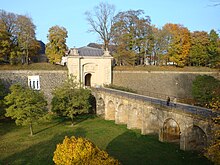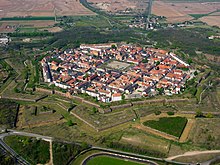Fortifications of Vauban UNESCO World Heritage Sites
| UNESCO World Heritage Site | |
|---|---|
 | |
| Location | France |
| Includes | 12 locations in France |
| Criteria | Cultural: (i), (ii), (iv) |
| Reference | 1283 |
| Inscription | 2008 (32nd Session) |
| Area | 1,153.16 ha (2,849.5 acres) |
| Buffer zone | 4,341 ha (10,730 acres) |
| Coordinates | 47°14′10″N 6°1′37″E / 47.23611°N 6.02694°ECoordinates: 47°14′10″N 6°1′37″E / 47.23611°N 6.02694°E |

The Fortifications of Vauban is made up of 12 groups of fortified buildings and sites along the borders of France. They were designed by military architect Sébastien Le Prestre de Vauban (1633–1707) during the reign of King Louis XIV, and were added in 2008 to the list of UNESCO World Heritage Sites.
The network of major sites of Vauban is an association of cities created on March 30, 2005 at the initiative of the city of Besançon. It includes the twelve sites which best represent the fortification system erected by Vauban. Its aim is to highlight and inscribe Vauban's remarkable work on the UNESCO World Heritage List. The application file was selected on January 5, 2007 by the Ministry of Culture to represent France.[1] On July 7, 2008, twelve of the network's fourteen sites were added to the list at the UNESCO annual meeting in Quebec City.[2]
History[]
In 2003, the city of Besançon investigated the possibility of a UNESCO World Heritage nomination. After taking the advice of specialists, they decided to mount an application in the form of a network representing the entire genius of the architect Sébastien Le Prestre de Vauban, to best meet the criteria issued by UNESCO. An initial selection of eight sites was formed in 2005, followed by a final list of fourteen sites, out of the 150 fortifications left by Vauban. The selections were finally validated by a scientific council on March 31, 2006. (In competition with the potential UNESCO World Heritage nomination, consisting of the works of Le Corbusier, each country could submit only one file each year).
The Vauban network was finally selected on January 5, 2007 by the Ministry of Culture, as the celebrations for the tercentenary of the architect's death began.
On July 7, 2008, twelve of the fourteen network sites are admitted to the final World Heritage List. The sites of Bazoches Castle in the Nièvre and the fort transformed into a citadel of the Palace at Belle-Île-en-Mer in Morbihan were excluded from the registration.[2] The citadel of Belle-Île-en-Mer has been rejected by UNESCO for its "lack of authenticity", particularly due to a hotel project within it. Although this raised questions, the fact that these two sites were private properties would not have played a part in this decision.
The twelve sites[]

There are twelve sites in total.
Vauban Citadel, Arras[]
The Vauban Citadel, located in Arras, Pas-de-Calais, was built by Vauban from 1667 to 1672. The Citadel has been nicknamed La belle inutile (the beautiful useless one) by residents as it has never been directly involved in heavy fighting, and ultimately failed to prevent the Germans from occupying the city in either World War. Within the citadel on the side of La Place de Manœuvre a small Baroque-style chapel was built. Outside, Le Mur des Fusillés (the wall of the people executed by a firing squad) pays tribute to the 218 members of the French Resistance shot in the citadel's ditch during World War II.
Citadel of Besançon[]
The Citadel of Besançon, in Besançon, Doubs, is considered one of Vauban's finest works of military architecture. The Citadel occupies 11 hectares (27 acres) on Mount Saint-Etienne, one of the seven hills that protect Besançon, the capital of Franche-Comté. Mount Saint-Etienne occupies the neck of an oxbow formed by the river Doubs, giving the site a strategic importance that Julius Caesar recognised as early as 58 BC. The Citadel overlooks the old quarter of the city, which is located within the oxbow, and has views of the city and its surroundings. The Citadel is built on top of a large syncline on a rectangular field crossed across its width by three successive bastions (enclosures, or fronts) behind which extend three plazas. The whole is surrounded by walls covered by circular paths and punctuated by watchtowers and sentry posts. The walls are up to 15 to 20 metres (49 to 66 ft) high with a thickness between 5 and 6 metres (16 and 20 ft). Also included in this site is Fort Griffon.
Sites at Blaye-Cussac-Fort-Médoc[]
The citadel of Blaye, city walls, Fort Paté and Fort Médoc are located in Blaye-Cussac-Fort-Médoc, Gironde.
Briançon, Hautes-Alpes[]
The Fort des Trois-Têtes and the Fort du Randouillet, along with city walls, Redoute des Salettes the ouvrage de la communication Y and the Asfeld Bridge, are located in Briançon, Hautes-Alpes.
Tour Vauban[]
The Tour Vauban, also known as the Tour dorée (meaning "Gilded Tower") is in Camaret-sur-Mer, Finistère. It is an 18m-high polygonal defensive tower built to a plan by Vauban on the Sillon at Camaret-sur-Mer, as part of the fortifications of the goulet de Brest. It has three levels and is flanked by walls, a guardhouse and a gun battery which can hold 11 cannons as well as a cannonball foundry added in the French Revolution period.
Ville neuve, Longwy[]
The ville neuve (meaning new city) is located in Longwy, Meurthe-et-Moselle.
Place forte, Mont-Dauphin[]
The sight of the place forte is located in Mont-Dauphin, Hautes-Alpes.
Citadel and city walls, Mount-Louis[]
The citadel and city walls of Mont-Louis are located in Mont-Louis, Pyrénées-Orientales.
Ville neuve, Neuf-Brisach[]
The ville neuve in Neuf-Brisach, Haut-Rhin is located close to the German border with France.
Citadel and city walls, Saint-Martin-de-Ré[]
A Citadel and city walls are located in Saint-Martin-de-Ré, Charente-Maritime.
Watchtowers, Saint-Vaast-la-Hougue[]
Watchtowers are located along Saint-Vaast-la-Hougue/Tatihou, Manche.
Sites at Villefranche-de-Conflent[]
Fort Libéria, Cova Bastera, and citt walls are located in Villefranche-de-Conflent, Pyrénées-Orientales.
Two sites initially considered were removed from the final list: A château in Bazoches, Nièvre, and the citadel and walls surrounding Le Palais in Belle-Île-en-Mer, Morbihan.
Gallery[]
See also[]
- Vauban fortifications
- Sébastien Le Prestre de Vauban
References[]
- ^ Article du journal Le Monde du 6 janvier 2007 [archive].
- ^ Jump up to: a b Douze fortifications de Vauban au patrimoine mondial de l'Unesco [archive] dans Le Monde du 7 juillet 2008.
External links[]
- http://www.sites-vauban.org/ (in French)
| Wikimedia Commons has media related to Fortifications of Vauban. |
- Vauban fortifications in France
- World Heritage Sites in France
- 7 Most Endangered Programme


